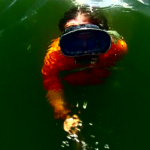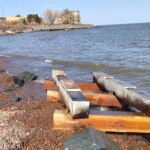Ark of the Anthropocene Retrospective
Remember Sean Connaughty’s roughly 4,000-pound “Ark of the Anthropocene” sculpture, which was dropped into the Duluth Harbor last summer and floated for about three days before sinking? Well, a little video retrospective has emerged.
Here’s Connaughty’s full description of it all:
The Ark is a biosphere float, containing an ecosystem. It’s an idea/design for the future. An object such as this one could be used to preserve ecosystems, as a site for agriculture, or as a space for habitation. As sea levels rise in the decades to come and land availability decreases, we will need solutions.
The Ark is a community-sourced project, built with the help of two institutions (the Weisman Art Museum and the Duluth Art Institute), as well as crowd sourcing through a successful Kickstarter campaign. It was made with the expertise and labor of several local craftspersons, artists, and scientists. I myself spent hundreds of hours building the Ark in my Standish backyard. It has a sturdy steel armature and is made with high-strength concrete. The Ark weighs 4,000 pounds and contains a solar-powered light and a time capsule with artifacts and bio-data, including seeds and samples of human hair, animal fur, and feathers preserved in sealed vials. Data selections were curated by researcher Ryan Seibold.
The Ark was transported by crane and truck to Duluth, where it was launched in Lake Superior. It was an exciting moment. The Duluth press was on hand, and many people watched from the shore as the Ark was lowered into the Duluth harbor. From a boat, and by swimming, I attached the ark to its anchor and released it from the crane.
The Ark floated successfully for about 70 hours. Unfortunately, it suffered some damage and sank. The shackles on the hardware attached to the Ark twisted and caused a small hole that allowed the air to slowly escape. Thus, on its first launch, the Ark ended up on the bottom of Lake Superior.
I was present when the Ark began to sink. I swam around it and tried to resolve the problem. It was a harrowing experience. The water in Lake Superior was extremely cold, even though I was wearing a wet suit, and strong currents from the St. Louis River made the work difficult. I tried to use an air pump to replenish the air, but that failed. I tied a rope to the Ark and removed the solar panels to keep the panels from being destroyed by the waves and/or submersion. The attached rope would allow divers to easily locate the ark. Andy Citarella from the Great Lakes Aquarium was there to spot me while I was swimming. I had gone to my car to get supplies when the Ark finally went down.
A salvage operation followed. Annie Dugan, director of the Duluth Art Institute, located scuba divers with the help of the Great Lakes Aquarium, and a Duluth company, Viant Crane, a previous contact of mine, came with a crane within two hours of the sinking. We stayed in communication with the Coast Guard as we worked to pull the Ark out. The scuba divers attached the crane cables to the Ark, and the crane lifted it out of the water, which was 20 feet deep in that location.
When the Ark was full of water, it weighed 13,000 pounds (there was a scale on the crane). I was pleased that the structure and hardware of the Ark supported this massive weight without any major damage. The only damage was the little hole in the hardware. About 90% of the plants inside the Ark were washed out; the soil and some of the hardiest plants remained. The time capsule was fine, and the light still worked.
I was very disheartened at the time of the sinking. I have since gained some perspective and feel that this experience will add to the richness of the tale of the Ark. I am also determined that the Ark will float again. I am currently working on permission to launch it in Lake Hiawatha this spring, as well as garnering the resources for the launch. I am confident that the concept and design are sound. It’s only natural that a new concept will endure a few setbacks. I welcome your feedback and invite you to check out the Ark as the ecosystem recovers from its submersion. (I’m using straw bales to insulate the plants this winter.) I thank the neighborhood for your interest and support through all of the Ark’s adventures.
Recommended Links:
Leave a Comment
Only registered members can post a comment , Login / Register Here















No Comments